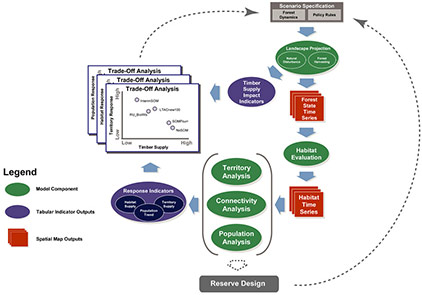Recovery planning under the Species at Risk Act (SARA) is a complex process requiring syntheses of ecological data about the species, derivation of population and distribution objectives, and incorporation of stakeholder input. Methods of dynamically projecting habitat conditions, and the effects of management activities on future habitat and population can greatly assist recovery teams in developing recovery and habitat action plans. For the endangered Northern Spotted Owl in Canada, our solution was to develop spatially-explicit models that combined forest dynamics and management models with habitat and population models.
In collaboration with the Canadian Spotted Owl Recovery Team (CSORT) and Gowlland Technologies Ltd., Cortex developed a suite of models that link forest management and disturbances with habitat, territory and dispersal models as well as population models for the Northern Spotted Owl. Spatial and temporal indicators needed for decision analysis were output in a form that allowed other post-processing tools to incorporate them in making more detailed assessments of habitat and population recovery options.
During development of the models, Cortex worked closely with biologists and stakeholders to ensure they were focused on the central ecological issues and management questions, such as identification of critical habitat, determining the course of the recovery planning.


